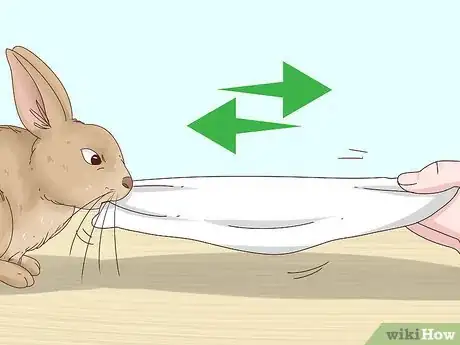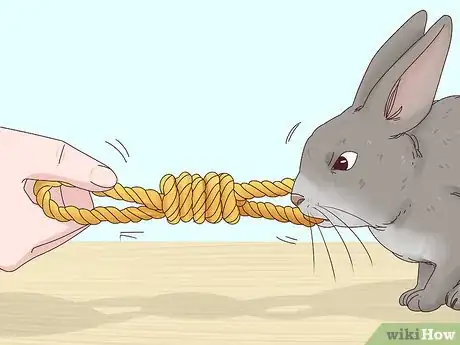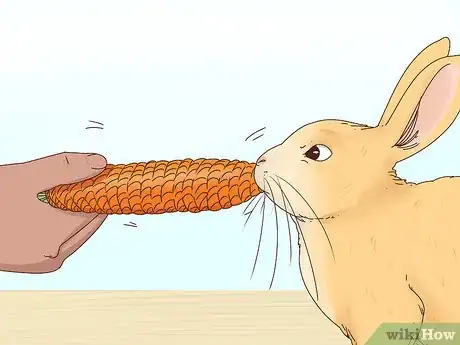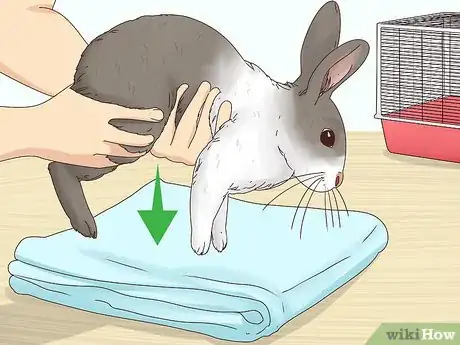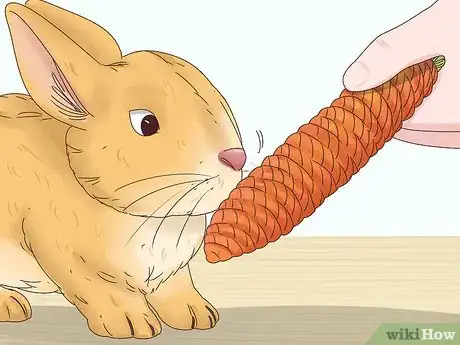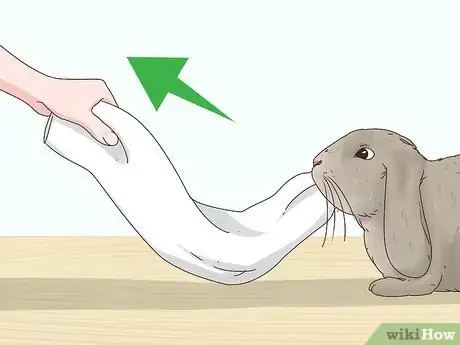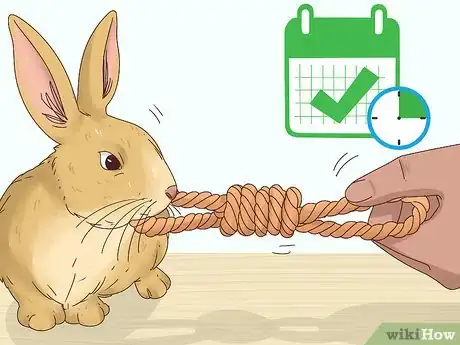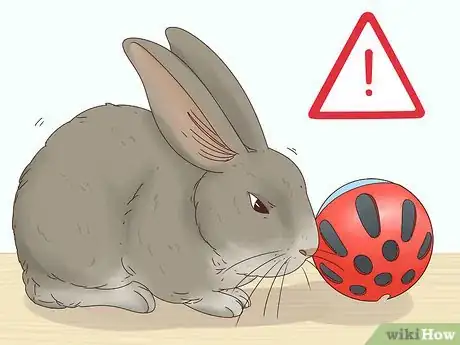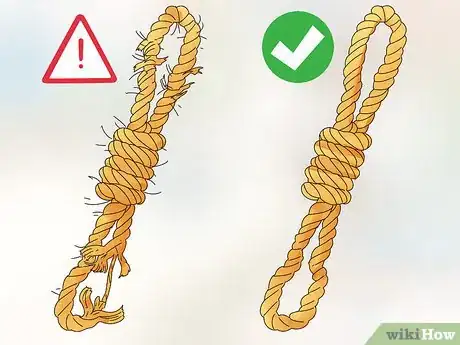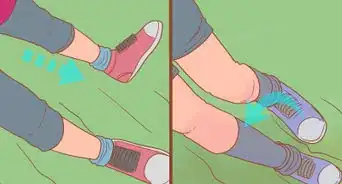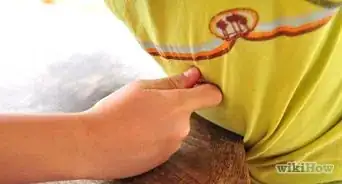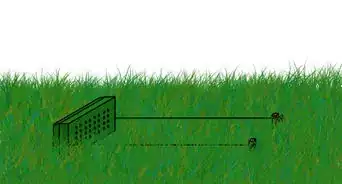X
This article was co-authored by Ryan Corrigan, LVT, VTS-EVN. Ryan Corrigan is a Licensed Veterinary Technician in California. She received her Bachelor of Science in Veterinary Technology from Purdue University in 2010. She is also a Member of the Academy of Equine Veterinary Nursing Technicians since 2011.
This article has been viewed 11,515 times.
Rabbits love to play with their owners, as it allows them to socialize and get some exercise. One simple game you can play with your rabbit is tug of war. Pick items suited for playing tug of war with the rabbit. Then, play the game safely with your furry friend so it is fun for both of you.
Steps
Part 1
Part 1 of 3:
Choosing Items for Tug of War
-
1Get a long towel. Rabbits like to bunch up towels with their noses and paws. They can also play tug of war with a towel. Give the rabbit a towel that is long and thick, such as an old dish towel.
- Make sure there are no holes in the towel and that the towel is made of thick material.
- Avoid towels that are dirty or once used for potentially hazardous tasks (e.g., old rags used for varnishing or on other toxic chemicals).
-
2Use a toy rope. Rabbits can also play tug of war with a toy rope made out of woven cloth. You can buy toy ropes for bunnies at your local pet store or online. Look for a toy rope that is small enough for your rabbit to handle.[1]
- You can use toy ropes made for very small dogs, or designed specifically for rabbits. Alternatively, you can make your own by tying knots along a thick strip of felt or terry cloth.
- Avoid rope toys made of plastic or nylon, as they can be hard on your rabbit’s teeth. Hemp or felt are good options.
Advertisement -
3Get a long chew toy. Rabbits love chew toys and you can repurpose them for a game of tug of war. Look for chew toys made of natural fibers like grass, hay, and corn leaf. Most chew toys for rabbits are long and narrow in shape, making them perfect for tug of war.
- You can find chew toys for rabbits at your local pet store or online.
- You can also make your own chew toy for your rabbit at home by repurposing cardboard tubes from toilet paper or paper towels.
- Always take away any cardboard tubes that have holes or tears in them so the bunny does not swallow any cardboard.
Advertisement
Part 2
Part 2 of 3:
Playing Tug of War
-
1Take the rabbit out of its cage in a contained area. Start off playtime by lifting the rabbit out of its cage and placing it on a soft surface like a carpet or towel. Make sure you close all doors and windows so the rabbit cannot escape.
- Make sure you have a non-slip surface for your rabbit. This helps protect its legs and back during play time.
- You can also take out the towel or toy so it's nearby.
-
2Let the rabbit grip the towel or toy. Approach the rabbit with a towel or toy. Let the rabbit smell the towel or toy and chew on it. Wait until the rabbit has the towel or toy in its mouth.
- You can encourage the rabbit to grip the towel or toy by putting it directly in front of the rabbit’s mouth. It may then sniff the towel and start to chew on it.
-
3Pull gently on your end of the towel or toy. Once the rabbit has the towel in its mouth, gently tug on the other end. Do not yank or tug too hard on the towel, as this can damage your bunny’s teeth. Give the towel a light pull so the rabbit can pull it back.
- Never try to pull the rabbit along with the towel, as this can injure its teeth. Don't jerk it from side to side, either, as this can injure it's neck, jaw, and spine. Instead, only pull gently enough to give a little resistance to the bunny’s tugs.
-
4Switch to other games after a few rounds. Tug of war is a fun game for your bunny, but it can be hard on its teeth and mouth. Have a few rounds of tug of war with the rabbit, then switch to other games. Allow the bunny to play with other toys or on its own. This way, the rabbit’s teeth and mouth are not at risk of injury.[2]
- Rabbits like to climb and hop around, especially on ramps and soft surfaces like carpet. You can play a game where you encourage the rabbit to climb or hop to a certain spot by tapping on the spot. You can also use a treat to encourage it to climb or hop.
- You can also use a rubber ball to play with the rabbit. Try rolling the ball to the rabbit. Encourage it to roll the ball back to you by making a rolling motion at the rabbit.
-
5End playtime with petting and a treat. Wind down the rabbit at the end of the play session by petting its head and belly gently. Do this for one to two minutes so the rabbit can calm down.
- You can also offer the rabbit a treat as a reward for a good play session.
Advertisement
Part 3
Part 3 of 3:
Staying Safe When Playing
-
1Schedule regular play time with the rabbit. Make an effort to play with the rabbit at least once a day for ten to fifteen minutes. Schedule in playtime with the rabbit at the same time every day.
- For example, you may designate ten to fifteen minutes in the morning before school for playtime. Or you may make play time with the rabbit at night before bed.
-
2Check for signs of stress or agitation in the rabbit. If you notice the rabbit displaying behavior like growling, hunching, hiding, or sitting still, the rabbit may be stressed. Stop playing with the rabbit and let it have some time on its own.
- Once the rabbit moves around more and appears more relaxed, you can start playing with it again.
-
3Replace any toys that are chewed up. Make sure you inspect the rabbit’s toys for any holes or tears. Replace them right away, as you do not want the rabbit to be at risk of swallowing or choking on any pieces of the toy.
- Rabbits can chew through towels and toys relatively fast so be diligent and always check your bunny’s toys after a play session. Do not allow your rabbit to play with torn or ripped toys.
- If your rabbit has toys that are in good shape but that no longer interest them, you can always donate them to a rescue or shelter.
Advertisement
References
About This Article
Advertisement
